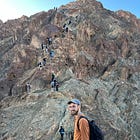Is Eilat Relevant?
The southern border of Natural Israel is at least 30 miles to the north.
Today’s post is a tad technical, a bit long, and dreadfully important. So if Jewish geography (the literal type) isn’t your thing, maybe skip to the insight near the end.
The Southern Border Mystery
Dear Healthy Jew,
God set the borders of the Promised Land in several places in the Torah.
Many of them are easily identifiable: the Mediterranean to the west, the Euphrates (yup, not the Jordan) to the east and northeast.
But the southern border is a different story.
Because it runs through the desert, the Torah mentions a series of places (towns? outposts? trail markers?) that mark the end of biblical Israel: Ma’aleh Akrabim, Chatzar Adar, Atzmon, and some others (Bamidbar/Numbers 34).
Nobody knows today for sure where those places are. So nobody knows for sure where Natural Israel’s southern border lies.
During the Covid lockdowns, I spent several months researching the borders of biblical Israel and pondering their significance. Regarding the southern border dilemma, I’m more convinced by the “northern” opinions that place it along or near the Zin Riverbed, which is around 90 miles north of Eilat.
One of the proofs for this view is that the Torah places the Dead Sea and its environs at biblical Israel’s southeastern corner - which would suggest the southern border runs near that latitude. Even though at times the border line drops south (as the Torah implies), it shouldn't descend so far that the Dead Sea won’t anymore be the clear turning point from east to south.

30° Latitude
Although it’s still possible the border is somewhat beyond the Zin Riverbed, there’s no way it reaches Eilat.
How do we know?
Because the Rambam (Maimonides) wrote regarding certain complex astronomical equations that no point in Israel is lower than 30° latitude.1 Eilat clocks in at 29°33′25″, and Har Shlomo to its north - the mountain I told you about last week - is at 29°34′49″.
Close, but not quite.
And it’s not really that close. Every minute of latitude equals 1.15 miles, which puts Eilat and Har Shlomo around 30 miles away from the closest possible southern border of biblical Israel.
The Rambam didn’t pull his coordinates out of a hat. The Torah designated the Euphrates as the eastern frontier of biblical Israel’s Ever Hayarden region, and the Euphrates river pours into the Persian Gulf at almost exactly 30°.2
At least in that corner of modern Iraq, the far reaches of biblical Israel extend that far south. In the primary region of the Land - what the Torah calls Canaan - the border was probably farther to the north. In any event, it certainly didn’t reach Eilat.

“From the Red Sea to the Philistine Sea”
There’s another fascinating twist to the story.
In one of the Torah’s many descriptions of the Promised Land (Shemos/Exodus 23:31), we read that it extends “from the Yam Suf (Red Sea) until the Sea of the Philistines (Mediterranean Sea)”.
What?!?!
Haven’t I been telling you that it can’t get closer than 30 miles from Eilat - the city that sits on the Red Sea?
Since when was the Eilat located opposite the Mediterranean Sea? (It’s not.)
A careful reading of Rabbi Yehuda Halevi’s (c. 1074-1141) Kuzari shows that one question answers the other.
The Torah refers here to the western “finger” of the Red Sea, which juts slightly higher than the Eilat’s eastern “finger” - and reaches almost exactly 30°, just like the mouth of the Euphrates.3 That part of the Red Sea indeed lies across from from the Mediterranean. The Torah was teaching the north-south border of Israel along its western edge.
I find it utterly fascinating how well God knew geography: there’s no other way He could have singled out both the Euphrates (to the east) and the Red Sea (the one that’s across from the Philistines’ Sea) at the southern edges of His Chosen Land. Considering that He created the whole thing, it kinda makes sense that He’d get these nuances.
To appreciate the precision here, take another look at the map.

The Land of Prophecy
Now, if the Torah’s southern border places happen to all be on the 30th parallel, that would dovetail nicely with what we learned from the Rambam’s astronomical observations and Rabbi Halevi’s Red Sea verse interpretations.
But if they are way farther north, as they probably are, and only near the far-away Euphrates does the Ever Hayarden region touch 30°, how can the Torah refer to the tip of the western “tongue” of the Red Sea as the southern border?
From my analysis of the Kuzari, I understand that the Red Sea border refers to a future completion of biblical Israel that includes all the areas of the Sinai desert where the Jewish people traveled and their prophets heard God. But today, for most practical purposes, biblical Israel ends by the Torah’s line of outposts.4
Again, just in case it wasn’t clear, all the sources indicate that this future area too doesn’t reach beyond 30° - the shore of the Red Sea’s western “tongue.” So Eilat is completely out.
I’m aware there are many opinions about the southern border of biblical Israel. Maybe you’ve heard a different approach than what I’ve presented here. Of course, I respect all faithful scholarship based on legit sources.
You can learn much more about my take on this complex subject from this little book (attached here) I wrote about the location and significance of biblical Israel’s borders. Warning: it’s in Hebrew.
The Jews of Eilat
Must we conclude from all this that visiting Eilat is like visiting Paris?
I don’t think so. There is Jewish history here - not as tragic exile, but in some of our proudest periods.
Shlomo (and other kings of Yehuda/Judah) ruled over Eilat. The local mines might have produced the gold and copper of the Beis Hamikdash (Temple) that he built.
Moshe (Moses) talked in the Torah about the Jewish people passing by Eilat.5
I’m not exactly sure what’s the message of Eilat, but I have a whiff of an idea.
This area was and is a trading outpost that connects Israel with the wonders of Africa and Asia. It’s not Israel - but the place where Israel and the world meet. Not to fight over land - it’s clear this doesn’t belong to Israel - but to exchange goods and ideas, to work together.
As the body of the Jewish nation, it makes sense that Israel has such a place, because Judaism contains a similar experience. The Torah is God’s wisdom that he gifted to the Nation of Israel - but Jews also recognize, appreciate, and interact with other wisdoms too. Put another way, the Torah doesn’t supersede the human intellect, but rests upon and completes what man perceives with his limited mind.
Shlomo - the Jewish king who settled Eilat - particularly excelled at the wisdoms of the world. Rulers from everywhere came to learn from the “wisest of all men,” the man who wrote books extolling “wisdom,” usually preferring the generic term over the specific focus of “Torah.”
That’s my thought. There’s lots more to explain and expand, maybe another day. And it might be wrong. But it also might be right.
Thank you for reading Healthy Jew.
Here are 2 great paths to continue the journey:
Also check out this intro and index to explore hundreds of posts about our 3 Healthy Jew topics: Wellness with Wisdom, Land of Life (Israel), and Sensible Spirituality.
Finally, always feel free to reach out here with any comments, questions, or complaints:
I look forward to hearing from you!
Be well,
Rabbi Shmuel Chaim Naiman
Hilchos Kidush Hachodesh 18:16
Maimonides added that Israel doesn’t reach higher than 35°, because that’s where the Euphrates veers northeast and ceases to be the northern border of biblical Israel.
Kuzari 2:14, 4:3
Rabbi Ariel Buckwald, in his wonderful book Ani Hashem Shochen Besocha (see my synopsis linked above), has a different interpretation of the Kuzari. We’ve had many heated phone and email conversations about this, but I still haven’t managed to convince him.
Devarim/Deuteronomy 2:8









